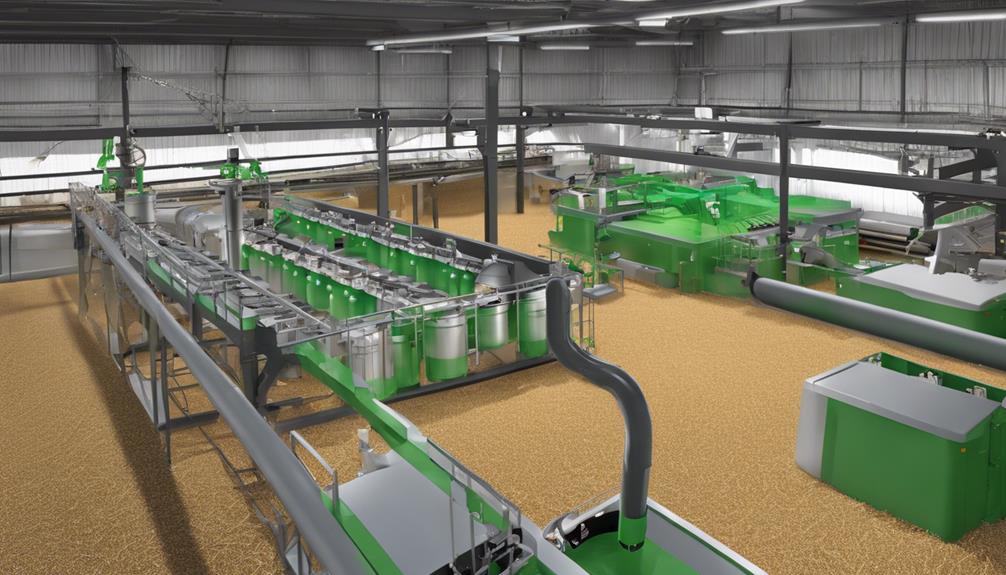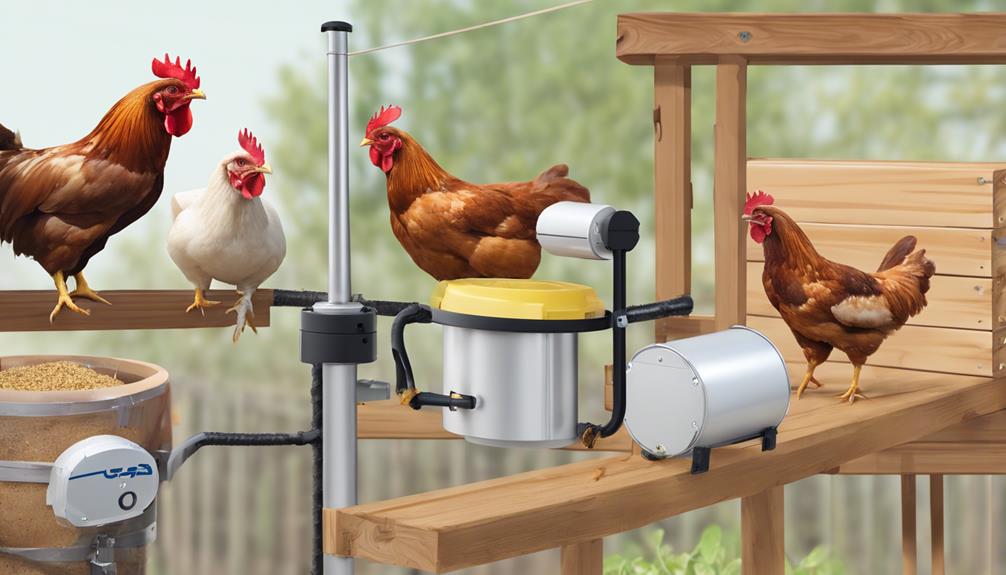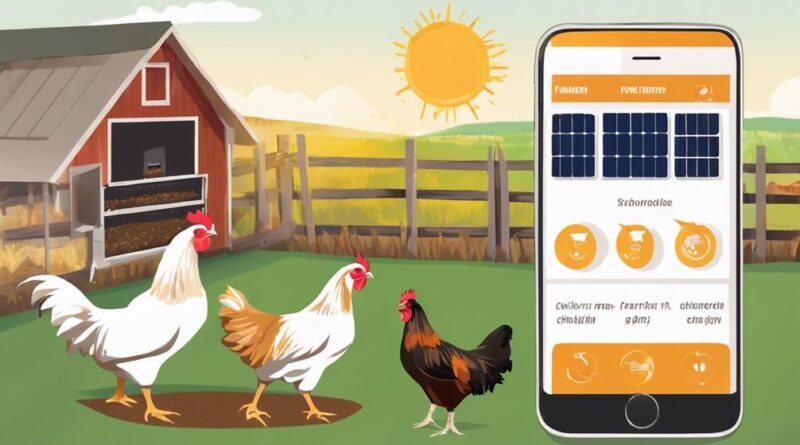10 Innovative Chicken Feed Technologies for Farmers"
Discover cutting-edge chicken feed technologies, including automated systems for precise feeding, tailored nutrition solutions, and smart feed dispensers streamlining processes. Embrace data-driven management for optimized formulations and predictive modeling. Boost poultry health with probiotic supplements enhancing digestion and immunity. Explore innovative farming techniques, like vertical systems and hydroponic farming. Optimize resource utilization for sustainability and profitability. Learn about solar-powered feeders, IoT integration, and feed conversion strategies. These advancements revolutionize poultry farming efficiency, empowering you to elevate your operations and ensure healthier, more productive flocks.
Automated Feeding Systems
Automated feeding systems in the poultry industry have revolutionized the way farmers manage and distribute feed to their chickens. With advancements in technology, feeding efficiency monitoring has become a critical aspect of poultry farming. Integrating robotic feeders allows for precise control over the amount of feed distributed to each chicken, optimizing consumption and reducing waste. These systems provide farmers with real-time data on feeding patterns, enabling them to make informed decisions to enhance the overall health and growth of their flock.
Remote feeding control is another key feature offered by automated systems. Farmers can now monitor and adjust feeding schedules from a distance, saving time and ensuring consistent feed distribution. This capability is particularly useful for large-scale poultry operations where manual feeding would be time-consuming and labor-intensive. By remotely controlling the feeding process, farmers can maintain a regular feeding routine, leading to healthier and more productive chickens.
Furthermore, the integration of AI-powered feeding solutions has taken automated feeding systems to the next level. These intelligent systems analyze data on chicken behavior, feed consumption, and environmental conditions to optimize feeding schedules and quantities. By leveraging AI technology, farmers can achieve higher feed efficiency, reduce costs, and improve overall poultry health. The combination of robotic feeders, remote control capabilities, and AI-powered solutions represents the cutting edge of automated feeding systems in the poultry industry.
Precision Nutrition Solutions
Implementing precise nutritional solutions is crucial for optimizing chicken health and performance in modern poultry farming practices. To achieve this, farmers can employ various feeding efficiency strategies and nutrient dense formulations. Here are five key points to consider:
- Balanced Diet Formulation: Utilize advanced software programs to create well-balanced diets tailored to the specific nutritional requirements of different stages of chicken growth.
- Nutrient Analysis: Regularly conduct nutrient analysis of feed ingredients to ensure accurate formulation and adjust as needed to meet the changing nutritional needs of the chickens.
- Precision Feeding: Implement precision feeding techniques to deliver the right amount of feed with the correct nutrient composition to each chicken, maximizing growth and health while minimizing waste.
- Performance Monitoring: Use performance monitoring tools to track key indicators such as weight gain, feed conversion ratios, and overall health to fine-tune nutritional strategies for optimal results.
- Quality Control Measures: Establish stringent quality control measures to ensure the consistency and quality of feed ingredients, preventing variations that could impact the effectiveness of the nutritional solutions.
Smart Feed Dispensers
Utilize cutting-edge technology in poultry farming by incorporating smart feed dispensers to streamline feeding processes and enhance efficiency. Smart feed dispensers revolutionize traditional feeding methods by integrating advanced features such as feeding behavior analysis, smart feed sensors, real-time feed monitoring, and automated portion control.
Feeding behavior analysis is a key component of smart feed dispensers. These devices are equipped with sensors that gather data on how chickens interact with the feeding system. By analyzing factors like feeding frequency, duration, and consistency, farmers can gain valuable insights into the birds' nutritional needs and overall health.
Smart feed sensors play a crucial role in optimizing the feeding process. These sensors detect when a chicken approaches the feeder, triggering the dispensing of the appropriate amount of feed. This real-time feed monitoring ensures that each bird receives the correct portion size, leading to more efficient feed utilization and reduced wastage.
Automated portion control further enhances the efficiency of smart feed dispensers. By programming the dispensers to deliver specific amounts of feed at scheduled intervals, farmers can maintain consistent feeding routines and prevent overeating. This level of precision in feeding management contributes to the overall well-being of the flock and can result in improved growth rates and production outcomes.
Data-Driven Feed Management
Enhance poultry farming efficiency through the strategic use of data-driven feed management techniques. Utilizing sensor technology and nutritional optimization can significantly improve your poultry operation. Here are five key strategies to implement:
- Real-Time Monitoring: Install sensors in feeders and waterers to track consumption patterns and adjust feeding schedules accordingly. Real-time data analysis allows for precise adjustments to meet the birds' nutritional needs.
- Feed Composition Analysis: Use data analytics to assess the nutritional content of different feed batches. By analyzing this data, you can optimize feed formulations to ensure that your chickens receive the necessary nutrients for growth and health.
- Predictive Modeling: Implement predictive algorithms to forecast feed requirements based on factors like bird age, breed, and environmental conditions. This proactive approach helps prevent overfeeding or underfeeding, leading to better growth rates and feed utilization.
- Performance Tracking: Utilize data-driven tools to monitor key performance indicators such as feed conversion ratios and growth rates. By analyzing this data, you can identify trends and make informed decisions to improve overall flock performance.
- Automated Feed Adjustments: Integrate sensor technology with automated feeders to adjust feed portions based on real-time data. This ensures that birds receive the right amount of feed at the right time, leading to improved efficiency and cost savings.
Probiotic Feed Supplements
Introduce an innovative approach to poultry farming by incorporating probiotic feed supplements to enhance the health and performance of your flock. Probiotics are live microorganisms that, when administered in adequate amounts, confer health benefits to the host. When included in chicken feed, probiotics play a crucial role in promoting digestive health and immune support in poultry.
Maintaining optimal digestive health in chickens is essential for efficient nutrient absorption and overall well-being. Probiotic supplements aid in balancing the gut microbiota, which can improve digestion and reduce the risk of gastrointestinal disorders. By enhancing nutrient utilization, probiotics can contribute to better growth rates and feed efficiency in your flock.
Furthermore, probiotics offer valuable immune support to chickens, especially during periods of stress or disease challenge. These beneficial microorganisms help modulate the immune response, potentially reducing the incidence of infections and supporting faster recovery. A robust immune system is vital for ensuring the long-term health and productivity of your poultry.
Incorporating probiotic feed supplements into your chicken farming practices can lead to significant benefits for your flock. By prioritizing digestive health and immune support through the use of probiotics, you can optimize the performance and welfare of your chickens, ultimately enhancing the sustainability and profitability of your poultry operation.
Vertical Farming Innovations
Vertical farming innovations revolutionize the agricultural industry by maximizing space efficiency and crop yields through advanced cultivation techniques. When it comes to hydroponic chicken farming, automated vertical systems are at the forefront of this revolution. These systems allow for precise control over nutrient delivery, water usage, and environmental conditions, ensuring optimal growth for poultry.
- Automated Vertical Systems: These systems use cutting-edge technology to automate the process of planting, watering, and harvesting crops in vertical setups, reducing manual labor and increasing efficiency.
- Hydroponic Chicken Farming: By utilizing hydroponic techniques, farmers can grow crops without soil, directly impacting the feed available for chickens and enhancing the overall farming process.
- Urban Poultry Agriculture: Vertical farming is particularly beneficial for urban areas where space is limited. Urban poultry agriculture can thrive with the vertical integration of crop production and chicken farming.
- Innovative Stackable Feeders: Stackable feeders are designed to optimize space in vertical farming setups, providing chickens with easy access to feed while maximizing the use of available area.
- Efficient Resource Utilization: Vertical farming promotes sustainable practices by maximizing resource efficiency. This is crucial for the long-term viability of chicken farming in the face of increasing demands and environmental challenges.
Automated Feed Analysis Tools

Utilizing cutting-edge technology, automated feed analysis tools provide farmers with real-time data on the nutritional content of chicken feed, enhancing precision in diet formulation and optimizing poultry health. These tools employ sophisticated algorithms to conduct rapid and accurate nutritional analysis, allowing farmers to make informed decisions promptly.
Remote monitoring is a key feature of automated feed analysis tools, enabling farmers to track feed composition without the need for manual intervention continually. By remotely accessing data on the nutritional content of the feed, farmers can adjust formulations promptly, ensuring that their chickens receive the required nutrients for optimal growth and health.
Nutritional analysis provided by these tools goes beyond basic measurements, offering detailed insights into the feed's protein, fat, fiber, vitamin, and mineral content. This comprehensive information allows farmers to customize feed formulations to meet the specific needs of their poultry flocks accurately.
Furthermore, automated feed analysis tools contribute to increased efficiency in poultry farming operations. By streamlining the process of nutritional analysis and formulation adjustments, farmers can save time and resources while maximizing the health and productivity of their chickens. Embracing these technological advancements can revolutionize the way farmers manage their poultry feed, leading to better outcomes for both the animals and the farm's overall performance.
Solar-Powered Feeders
Enhancing poultry feeding efficiency, solar-powered feeders harness renewable energy to automate the distribution of feed, optimizing the feeding process for farmers. By integrating solar energy into the operation of feeders, several benefits can be observed:
- Reduced Operational Costs: Solar-powered feeders eliminate the need for electricity, cutting down on operational expenses associated with traditional feeders.
- Environmentally Friendly: Utilizing solar energy promotes sustainable farming practices, reducing the carbon footprint of poultry operations.
- Increased Reliability: Solar-powered feeders can function even in areas with unstable power grids, ensuring a consistent feeding schedule for the chickens.
- Customizable Feeding Schedules: These feeders can be programmed to dispense feed at specific intervals, allowing for precise control over the feeding regimen.
- Long-Term Investment: While the initial cost may be higher, solar-powered feeders provide a cost-effective solution in the long run due to lower operating costs and minimal maintenance requirements.
IoT Integration in Feeding

Integrating IoT technology into poultry feeding systems revolutionizes data monitoring and management, enhancing precision and efficiency in feed distribution processes. IoT monitoring allows for real-time tracking of crucial feeding metrics such as feed levels, consumption patterns, and environmental conditions. By leveraging IoT sensors and devices, farmers can remotely monitor and adjust feeding schedules, ensuring that chickens receive the right amount of feed at the right time.
Feeding optimization through IoT integration involves the analysis of collected data to identify trends and patterns that can lead to improved feeding practices. By utilizing machine learning algorithms and predictive analytics, farmers can optimize feed distribution, reduce waste, and enhance overall flock health. For example, if the data indicates that certain chickens aren't consuming their allocated feed, adjustments can be made promptly to prevent underfeeding or overfeeding situations.
Furthermore, IoT integration enables proactive maintenance of feeding equipment by providing alerts for potential malfunctions or issues. This predictive maintenance approach helps prevent downtime and ensures continuous operation of the feeding systems. Overall, integrating IoT technology in feeding systems not only streamlines data management but also empowers farmers to make informed decisions that ultimately benefit the health and productivity of their poultry.
Feed Conversion Optimization
To achieve optimal feed conversion rates in poultry farming, precise nutritional formulations tailored to specific growth stages are essential. When aiming to optimize feed conversion in chickens, incorporating feed additives and growth promoters into their diets can significantly enhance overall efficiency. Here are some key strategies to consider:
- Utilize nutrient absorption enhancers: These compounds improve the uptake of essential nutrients in the digestive tract, ensuring that chickens can make the most out of the feed they consume.
- Implement feed efficiency enhancers: By incorporating additives that specifically target improving feed conversion efficiency, farmers can reduce waste and maximize the nutritional benefits for the chickens.
- Consider growth promoters: These substances stimulate growth in poultry, helping them reach market weight more quickly and efficiently.
- Monitor feed intake carefully: Keeping track of how much feed chickens are consuming can provide valuable insights into their nutritional needs and help adjust formulations accordingly.
- Regularly assess performance: Conducting regular evaluations of feed conversion rates and overall growth can pinpoint areas for improvement and guide decision-making processes.
Frequently Asked Questions
Can These Innovative Chicken Feed Technologies Prevent Food Wastage?
Incorporating innovative chicken feed technologies can reduce spoilage and improve efficiency in preventing food wastage.
By utilizing advanced techniques such as precision feeding and tailored nutrient formulations, you can ensure that the feed meets the specific needs of your flock.
This targeted approach minimizes excess feed that goes uneaten, leading to a more sustainable and cost-effective poultry farming operation.
How Do These Technologies Ensure the Well-Being of Individual Chickens?
To ensure the well-being of your chickens, innovative feed technologies monitor chicken health and feeding behavior closely. By tracking individual chicken's intake and behavior patterns, these technologies can detect any signs of illness or stress early on. This proactive approach allows you to address any health concerns promptly, ensuring your chickens remain healthy and productive.
Are There Any Environmental Benefits Associated With These Feeding Solutions?
When using these feeding solutions, you benefit from reduced emissions and sustainable practices. The innovative technologies contribute to environmental benefits by minimizing waste and optimizing nutrient utilization.
Can These Technologies Be Customized for Different Chicken Breeds?
When considering breed specific customization for chicken feed technologies, it's crucial to analyze feeding efficiency.
By tailoring feed formulations to suit the specific nutritional requirements of different chicken breeds, you can optimize their growth, health, and overall performance.
This approach ensures that each breed receives the necessary nutrients in the right proportions, leading to improved productivity and well-being in your flock.
How Do These Technologies Address Challenges Related to Feed Contamination?
To address challenges related to feed contamination, innovative technologies focus on preventing contamination and ensuring safety. These methods involve rigorous testing protocols, quality control measures, and proper storage practices.
Conclusion
In conclusion, the advancements in chicken feed technologies have revolutionized the way farmers manage their poultry operations. From automated feeding systems to precision nutrition solutions, these innovative technologies have enhanced efficiency and productivity in the poultry industry.
By incorporating smart feed dispensers, data-driven feed management, and probiotic feed supplements, farmers can optimize feed conversion and improve overall bird health.
With the integration of IoT in feeding and solar-powered feeders, the future of chicken farming looks promising and sustainable.
